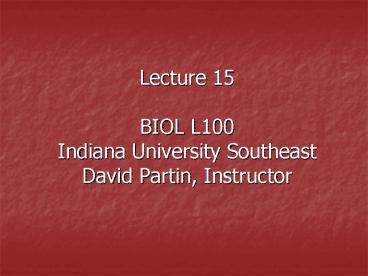Lecture 15 BIOL L100 Indiana University Southeast David Partin, Instructor - PowerPoint PPT Presentation
1 / 43
Title:
Lecture 15 BIOL L100 Indiana University Southeast David Partin, Instructor
Description:
B lymphocytes are made in the bone marrow and mature in lymph nodes. ... Mom's immune system recognizes that these cells are not like hers, so the baby's ... – PowerPoint PPT presentation
Number of Views:35
Avg rating:3.0/5.0
Title: Lecture 15 BIOL L100 Indiana University Southeast David Partin, Instructor
1
Lecture 15BIOL L100 Indiana University
SoutheastDavid Partin, Instructor
2
Todays Plan
- Announcements/Questions
- Lecture 15 Physiology overview (immunity,
digestion, urination, support locomotion) - One Minute paper
- Lab Dissection!
3
Layout of the Lymphatic System
Path of lymph? Where are lymphocytes made? What
are lymph nodes?
4
Part I
- Chapter 35
- Immune System
5
Tissues of the Immune System
6
The Immune Response
1
2
3
5
4
7
B lymphocytes are made in the bone marrow and
mature in lymph nodes.
Definitions antigen vs antibody
8
T lymphocytes are made and mature in the thymus.
9
T cells puncture target cells, causing damage
to their cell membranes and eventually death of
the target cell.
10
ABO blood antigens your plasma contains no
antibodies against the antigens found on your
blood cells.
Rh or - ??
11
Example of the immune system gone wrong
The same principle applies to rejected organ
transplants and blood transfusions.
Moms immune system recognizes that these cells
are not like hers, so the babys blood cells are
attacked.
12
Part II
- Chapter 36
- Digestive System
13
Digestive System
14
peristalsis
Breathing or swallowing, but not at the same
time...
Digestion begins in the mouth amylase breaks
down starch (carbohydrates).
15
Stomach
- made up of gastric glands
- coated with mucus
- produces acid (kills most bacteria)
- Enzymes break down protein
16
(No Transcript)
17
Small intestine
- About 10-12 ft long
- Intestinal wall is covered in villi
- Villi are specialized for absorption (tennis
court) - When chyme reaches small intestine, protein and
carbohydrate digestion are incomplete and fat
digestion hasnt begun yet. - Digestive juices from liver (via gall bladder)
and pancreas help to continue digestion.
18
Large intestine
19
Nutrients enter the bloodstream
20
Other organs of the digestive system
- Liver
- Bile production assists in fat, carbohydrate and
protein digestion - Monitors blood immediately after digestion
- Gall bladder
- Holds livers bile and releases into the duodenum
- Pancreas
- Secretes juices into duodenum that assist in
digesting fats, carbohydrates and proteins.
21
Need a break?
- Thanks for your attention!
- Take 10 minutes.
- Whats next?
- Urinary system
- Locomotion Support
22
Part III
- Chapter 38
- Urinary System
23
Urinary system
Very important for the maintenance of
homeostasis 1- Fluid regulation (hydration
blood pressure) 2- rids body of waste
24
Kidney structure
25
(No Transcript)
26
Bowmans capsule- Glomerulus-
27
(No Transcript)
28
(No Transcript)
29
(No Transcript)
30
Kidney structure
31
Renin-angiotensin-aldosterone system of blood
pressure regulation
32
Part IV
- Chapter 41
- Musculoskeletal System
33
The Human Skeletal System
- The skeleton supports and protects the body.
- The skeleton also allows for flexible movements.
- Bones serve as storage units for calcium and
phosphate. - Blood cells are produced in some bones.
34
Calcium phosphate are stored in a solid form
(bone) by osteocytes. When low levels of free
calcium or phosphate are detected in the blood,
osteoclasts break down bone and release these
minerals into the bloodstream.
Important cells in bone formation -osteoblasts
immature cells. -osteocytes mature
bone-producing cells. -osteoclasts mature
bone-degrading cells.
35
(No Transcript)
36
The Human Muscular System
- There are 3 main types of muscle cells
- Skeletal
- Smooth
- Cardiac
37
(No Transcript)
38
Muscle cell muscle fiber myoctye
Myofibril bundle of contractile proteins
39
(No Transcript)
40
(No Transcript)
41
Step 1- An action potential causes the motor
neuron to dump its synaptic vesicles into the
synaptic cleft. Step 2- Neurotransmitters from
the synaptic vesicles bind to receptors on the
muscle cell membrane, opening Na channels.
Step 3- The charge inside the muscle cell changes
because of all the Na rushing in. SR releases
stored Ca which helps actin myosin to form
cross bridges. Step 4- K rushes out of the
muscle cell to help bring the charge back to
normal. SR stops releasing Ca because charge is
normal again.
42
Need a break?
- Thanks for your attention!
- Take 10 minutes.
- Whats next?
- 1-minute paper
- Lab
43
Preparation for Lecture 16
- Read Ch 39 (starting with human nervous system on
page 699) - Ch. 40 pages 720-21, 723-26, 728-30































